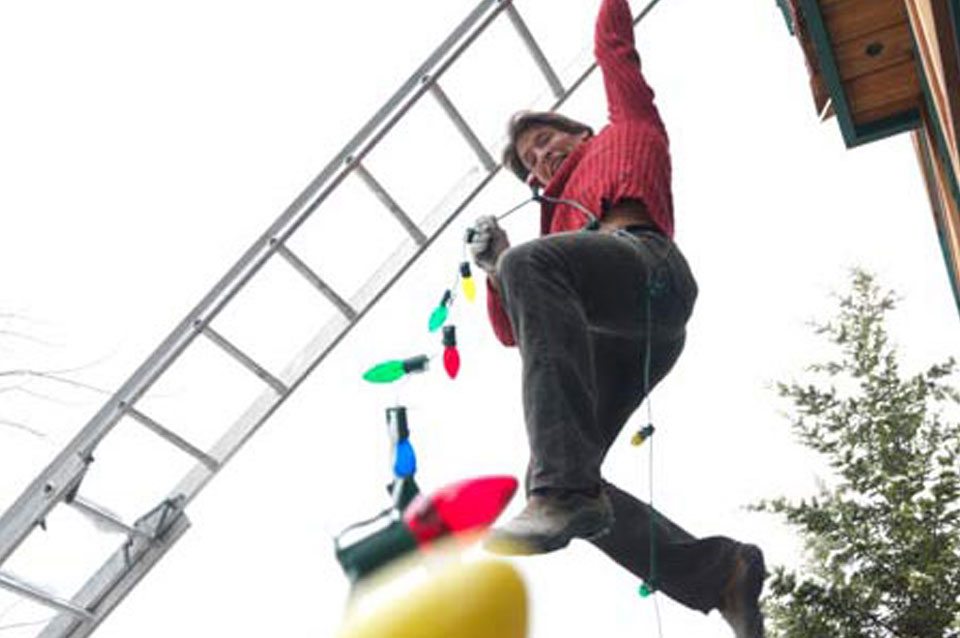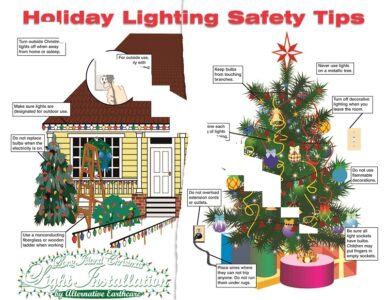Safety Tips for Installing Your Indoor & Outdoor Christmas Lights

Safety Tips for Installing Your Indoor & Outdoor Christmas Lights

Follow these Christmas safety tips when stringing your outdoor and indoor lights so you can celebrate the season in style without risking a tragedy:
Test and check over your lights
It’s always a good idea to plug in your lights before you hang them to look for bad bulbs. You should also look for frayed or loose wires, missing insulation and melted or mangled-looking bulb sockets, any of which could cause a short circuit and start a fire. Damaged light sets should be discarded or repaired.
Use good quality light sets
Just because they were cheap doesn’t mean they are a good deal. A good quality light set should be sturdy with a minimum of 22-gauge (awg) wiring, no loose connectors and have fuses at the plug to protect against overheating. Be sure to check the manufacturer’s UL label to ensure that any lights you intend to use outside were designed to safely weather the elements.
Use a GFCI outlet
Connect your outside lights to a Ground Fault Circuit Interrupting (GFCI) outlet. That way if there is a short or an overload on your lights, the GFCI outlet will trip before the breaker in your house. This serves as an added layer of protection against fires as well as coming in handy if your outside lights are on the same circuit as, say, the hall light inside your home.
Limit the length of your light strands
The circuits in your home may handle 15 to 20 amps, but remember that you might have more things plugged in than just your holiday lights. Furthermore, the thin wire on a light set isn’t usually designed to handle more than 1.8 amps of current (216 watts). That’s about five 40-watt strings as long as they are all the same bulb type and wattage. Many holiday light manufacturers advise connecting no more than three strings of incandescent lights together (LED sets can be longer). Be cautious and keep track of the number of lights, as overloading a string has been known to cause deadly fires.
Fasten your outdoor lights
When running wires outside, always fasten your lights to a stable mounting surface. However, avoid using staple or nails. Wire insulation can be accidentally pierced by staples and cause shorts or hard-to-find breaks. Wind-blown wire can have its insulation worn away as it rubs against staples or nails, again producing a risk for short circuit fires. Instead, use properly sized plastic light mounting clips or hooks. While stringing your display, keep your lights and wires well clear of electrical service lines connecting to your house, use only outdoor-rated extension cords and protect plug unions from being moved or getting wet.
Be safe while hanging your lights outside
One sometimes-overlooked aspect of outdoor Christmas light safety is avoiding injury while hanging the decorations in the first place. Between 2000 and 2019, there was an annual average of about 5,800 injuries from falls occurring while people were hanging their holiday decorations, with 43 percent occurring on ladders and 13 percent on roofs. Safe ladder usage means setting the ladder on stable ground and about one foot away from the wall for every four feet the ladder reaches up. Always work with someone to hold your ladder steady and keep yourself in the center as you move up and down. Never overreach or try to move the ladder when you’re at the top. And this should probably go without saying, but lay off the alcohol before you start climbing around on ladders.
Have adequate cord length for indoor lights
When running wires inside, always have adequate cord length for lights to reach an outlet. Avoid running extension cords under rugs and keep them away from areas of heavy foot traffic. Never overload extension cords with too many light sets, or outlets with too many plugs, as these can overheat. A power strip can provide a safer option.
Keep your Christmas tree well-watered
While the best way to prevent a fire is to keep the light strands in good shape and avoid overloading your circuits, you can further reduce your risk by maintaining a healthy level of water for your tree so the needles don’t dry out and provide easy kindling for a spark to light up.
Turn Christmas lights off when away
Finally, once you’ve inspected your light strands and hung them safely around your home, indoors and out, don’t forget one final Christmas light safety tip: Turn the lights off when you leave your home or go to bed at night. That way, if a problem does occur, someone will be at home and awake, giving them a better chance of addressing the issue before it turns into a major catastrophe.
Let Our Holiday Light Design Consultants Help you Create and Design The Lighting Spectacular You Want without the worry of everything described above.






